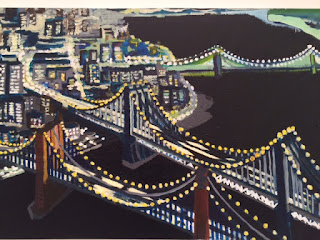The Joshua Liner Gallery in Chelsea is currently presenting a collaborative show featuring work by artists Sam Friedman and Josh Sperling for the show From the Cradle to the Grave.
Best friends since birth, the artists share a lifetime of shared personal and artistic experiences. About his friend, Sperling says “Sam and I have known each other for thirty years and have been making art alongside each other our entire lives. It feels natural to want to show your work with your friend… I have always looked at Sam’s work and found inspiration.”
Both artists grew up being influenced by Postwar masters such as Frank Stella and the late Ellsworth Kelly whose styles they incorporate in their work. Sperling’s structured canvases capture the changing effects of light and shadow on the surfaces of layered frameworks. One installation that stands out is Searching for Heaven that consists of white semi-circle acrylic shapes with thin arches visible forming the structure of a rainbow. The first piece sits flat on a piece of wood while the other pieces are stacked on top reaching up to the sky.
 |
|
Installation view of From the Cradle to the Grave
|
Other intriguing works of Sperling’s include his Love Potion series of several acrylic paintings each with its own color scheme like red and green, or green and blue, Skipping Stones which consists of four oval shaped structures and two creatures, on fat and round and one squiggly sliding over and under the oval shapes evoking the playful innocence of childhood, and Nocturnal Teenager depicting a sleeping adolescent with his tongue sticking out as a cloud separates his triangular shaped chin and brain which has a sky blue background with circles representing dreams.
Friedman’s works, on the other hand, are also acrylic paintings that are grayscale versions of paintings that originally featured bold, contrasting colors that dominated the canvas. With these grayscale versions, the strength of line and contrast are emphasized greatly and include scenes of nature with elements such as trees, grass, sunlight, and moonlight.
Sperling and Friedman have developed a visual dialogue with their methods. Sperling is focused on the process of putting together a painting by learning what goes into it while Friedman’s approach is more spontaneous as he’s guided by natural instinct. While the artists’ processes are quite different, their final goal is what brings them together as Sperling says, “We are both trying to achieve beauty.”
At The Joshua Liner Gallery, 540 W. 28th St., through Feb. 6. The gallery is open Tues.—Sat. from 11 a.m.—6 p.m.






